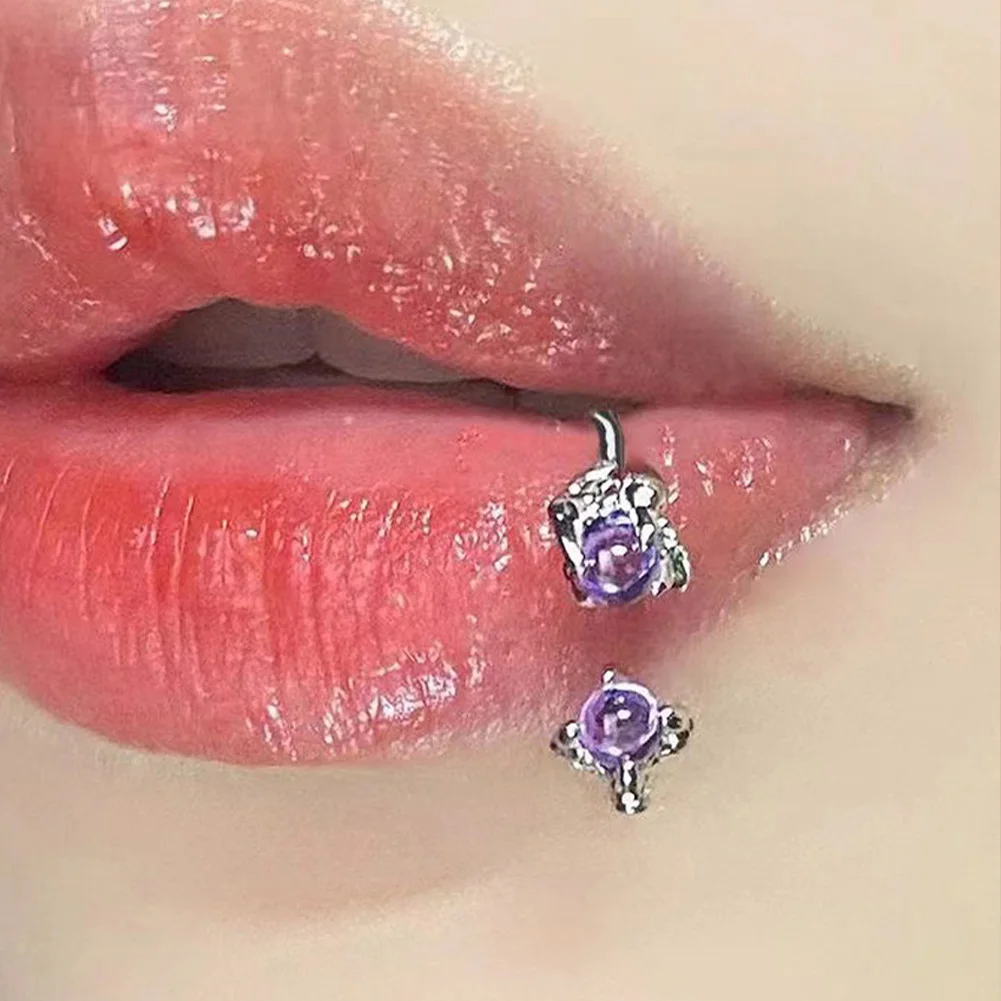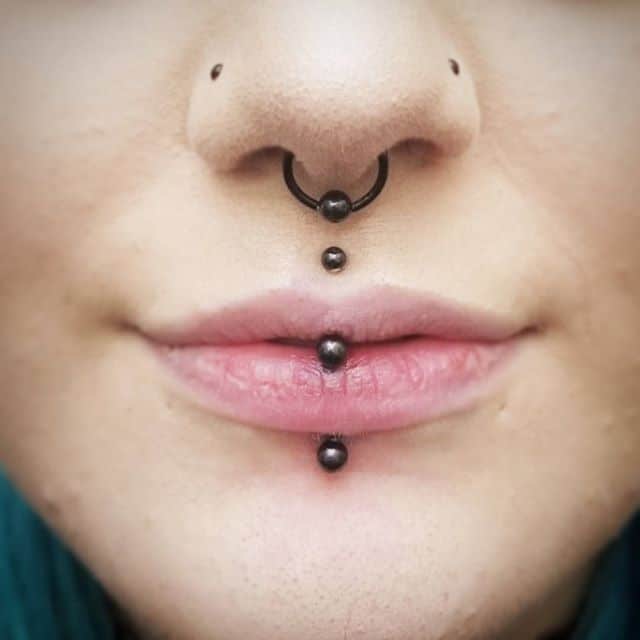Introduction
Piercings have long been a form of self-expression and a way to adorn the body. One of the more unique and intriguing types of lip piercings is the vertical labret. This piercing has grown in popularity in recent years, thanks to its distinctive look and relatively easy aftercare. In this article, we’ll delve into the world of vertical labret piercings, discussing everything from the procedure itself to the best aftercare practices.
Part 1: Understanding the Vertical Labret
At its core, the vertical labret piercing is a lip piercing that goes through the lower lip vertically. Unlike traditional labret piercings, which are placed on the lower lip horizontally, the vertical labret offers a different aesthetic that appeals to those looking for something a little more unique. This piercing can be customized with different types of jewelry, including rings, studs, and more, further allowing for personalization.
Level 1: The Procedure
The procedure for a vertical labret piercing typically involves the piercer marking the spot where the piercing will go and then using a hollow needle to create the hole. It’s important to find a reputable piercing studio and a professional piercer who follows proper hygiene and safety protocols.
Level 2: Jewelry Options
After the piercing is done, there are various jewelry options to choose from, including studs, hoops, and circular barbells. The size and style of the jewelry can be tailored to personal preference, allowing for individual flair.
Part 2: Potential Risks and Aftercare
As with any type of body piercing, there are potential risks and complications to be aware of when getting a vertical labret. It’s essential to understand the aftercare process to prevent infections and ensure proper healing.
Level 1: Potential Risks
Some potential risks of a vertical labret piercing include infection, swelling, and allergic reactions to the jewelry. It’s crucial for individuals to carefully follow aftercare instructions and seek medical attention if any issues arise.
Level 2: Aftercare Tips
After getting a vertical labret piercing, it’s important to clean the area regularly with a saline solution and avoid touching the piercing with dirty hands. Additionally, avoiding certain activities, such as smoking and kissing, can help promote proper healing.
Part 3: Pain and Healing Process
Like all body piercings, the pain and healing process associated with a vertical labret can vary from person to person. Understanding what to expect during and after the piercing is essential for a smooth healing experience.
Level 1: Pain Level
The pain level of a vertical labret piercing is typically moderate, with some discomfort during the procedure and in the days following. However, the pain is manageable for most individuals and often subsides relatively quickly.
Level 2: Healing Timeline
The healing process for a vertical labret piercing generally takes 6-8 weeks, during which time it’s crucial to follow aftercare instructions and monitor for any signs of infection or complications.
Part 4: Customization and Style Options
One of the appealing aspects of a vertical labret piercing is the ability to personalize the look with different jewelry and style options. This type of piercing can be a bold statement or a subtle accent, depending on individual preference.
Level 1: Customizing with Jewelry
There are countless jewelry options for a vertical labret piercing, allowing for personal expression and style. From simple studs to elaborate hoops, the possibilities for customization are nearly endless.
Level 2: Style Options
The vertical labret piercing can be styled in various ways, depending on individual preferences and fashion choices. Whether it’s a minimalist look or a more daring statement, the versatility of this piercing makes it a popular choice for those who love to experiment with their style.
Part 5: Common Myths and Misconceptions
As with many body modifications, there are common myths and misconceptions surrounding vertical labret piercings. It’s important to debunk these misunderstandings to ensure individuals have accurate information when considering this type of piercing.
Level 1: Misconceptions about Pain and Healing
One misconception about vertical labret piercings is that they are excessively painful and take a long time to heal. In reality, the pain is generally manageable, and the healing process is comparable to other lip piercings.
Level 2: Stereotypes and Stigmas
There may be stereotypes and stigmas associated with vertical labret piercings, particularly in professional or conservative environments. However, as with any form of self-expression, it’s crucial to challenge preconceived notions and embrace individual choices.
Part 6: Aftercare for Vertical Labret Piercings
Taking care of a vertical labret piercing is important to ensure proper healing and minimize the risk of infection. After getting the piercing, it’s important to follow the aftercare instructions provided by your piercer. This typically includes cleaning the piercing with a saline solution or a gentle, alcohol-free cleanser several times a day. It’s also crucial to avoid touching the piercing with unwashed hands and avoid manipulating the jewelry.
During the healing process, it’s normal for the piercing to be swollen, tender, and to produce some discharge. It’s important to avoid swimming in pools, lakes, or hot tubs until the piercing is fully healed to prevent infection. Additionally, practicing good oral hygiene is essential to prevent bacteria from entering the piercing site.
It’s also important to be mindful of the jewelry you choose for your vertical labret piercing. Initially, a longer piece of jewelry may be used to accommodate swelling, but it’s important to switch to a properly fitted piece once the swelling has gone down to prevent irritation.
Part 7: Risks and Complications of Vertical Labret Piercings
While vertical labret piercings are generally safe, there are certain risks and potential complications associated with the procedure. One of the most common risks is infection, which can occur if proper aftercare is not followed or if the piercing is exposed to bacteria. Signs of infection include increased redness, swelling, and discharge from the piercing site. If you suspect an infection, it’s important to seek medical attention promptly.
Another potential complication of vertical labret piercings is excessive scarring or keloid formation. This is more common in individuals with a predisposition to keloid scarring. Using proper aftercare and choosing high-quality jewelry can help minimize the risk of scarring.
In some cases, people may experience allergic reactions to the metal used in the jewelry. This can result in redness, itching, and discomfort around the piercing site. Choosing jewelry made from hypoallergenic materials such as titanium or niobium can help reduce the risk of allergic reactions.
It’s important to carefully consider the potential risks and complications of a vertical labret piercing before getting it done, and to choose a reputable and experienced piercer to minimize these risks.
Part 8: Vertical Labret Jewelry Options and Styles
Vertical labret piercings offer a wide range of jewelry options to suit different styles and preferences. One of the most popular jewelry choices for vertical labret piercings is the curved barbell. This type of jewelry follows the contour of the lip, providing a snug and secure fit. Curved barbells come in various materials, including titanium, stainless steel, and gold, allowing for customization and personalization.
Another popular option for vertical labret piercings is the captive bead ring. These rings feature a bead or ball that is held in place by tension, creating a seamless and classic look. Captive bead rings are available in different gauges and diameters, allowing for versatility in styling and personal expression.
For those looking for a more unique and unconventional look, there are also options such as circular barbells, horseshoe rings, and labret studs that can be customized with different gemstones or decorative ends.
When choosing jewelry for a vertical labret piercing, it’s important to consider the material, size, and style that best suits your individual preferences and lifestyle. Consulting with a professional piercer can help you make an informed decision about the best jewelry options for your vertical labret piercing.
Part 9: Vertical Labret Aftercare and Healing Process
After getting a vertical labret piercing, it is crucial to follow proper aftercare techniques to ensure a smooth healing process. Here are some essential tips for aftercare:
- Clean the piercing daily with a saline solution or non-alcoholic mouthwash to prevent infection and promote healing.
- Avoid touching the piercing with dirty hands to minimize the risk of introducing bacteria into the wound.
- Refrain from changing the jewelry until the piercing is fully healed to prevent irritation and complications.
- Be cautious when eating and drinking to avoid bumping or injuring the piercing site.
- Attend follow-up appointments with your piercer to monitor the healing progress and address any concerns.
It’s important to note that the healing time for a vertical labret piercing can vary from person to person, but generally, it takes about 6-8 weeks for the initial healing process. However, full healing may take several months, during which proper aftercare should be maintained.
During the healing process, it’s normal to experience some swelling, tenderness, and discharge around the piercing site. However, if you notice any signs of infection, such as excessive swelling, redness, or pus, it’s essential to seek medical attention promptly.
Conclusion
The vertical labret piercing is a unique and stylish way to adorn the lip, offering a range of customization options and a distinctive look. By understanding the procedure, aftercare, and potential risks, individuals can make informed decisions when considering this type of piercing. With proper care and attention, a vertical labret piercing can be a stunning addition to one’s personal style.





